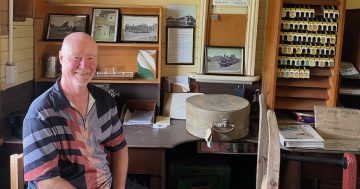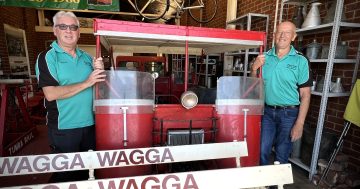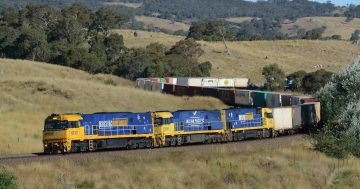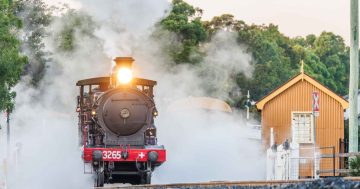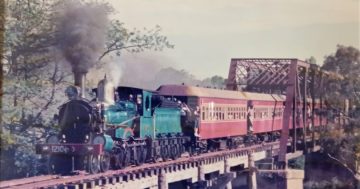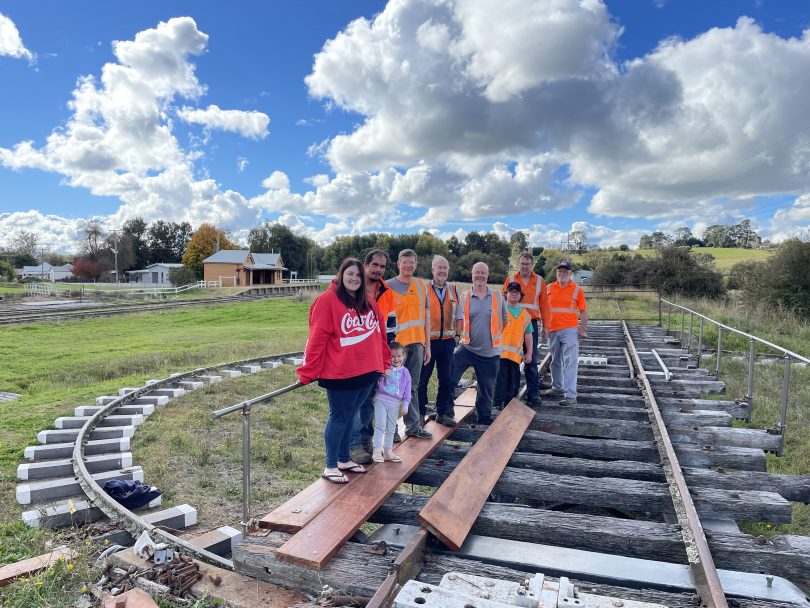
(Left to right) volunteers Carissa and Sophie Stewart (4), Lenny Stewart, Stephen Smith, Ian Barnes, president of the CHR Mick Bindley, Mikki Ovington, Colin Bolin and secretary GCHR Peter Simpson at the Crookwell Railway Station. Photo: Clare McCabe.
On 22 April 1902 the final steel railway sleeper was laid to complete the Goulburn to Crookwell railway line.
On its 120th anniversary, Crookwell Heritage Railway group members laid a new turntable deck and reinforced the railway sleepers’ supports at the heritage-listed terminus, proving it wasn’t the end of the line for the early 1900s railway station.
Though its last powerful steam train departed around the 1960s and the final train left the station in 1985, the railway line could become part of the NSW rail trails – non-operational parts of the country’s regional network of railways converted into shared-use paths for cycling, walking and sometimes horse-riding.
But closer to opening is the Upper Lachlan Ride the Rails Trail attraction by the Heritage Railway group, an enterprise for tourists to ride the rails on pedal-powered tandem and quad bikes from Crookwell to McCalister around 8 km away.
Crookwell Heritage Railway group secretary Peter Simpson said the attraction was well-positioned to open to passengers by the end of the year.
“There’s a lot of history involved in the railways and that’s part of the attraction,” he said.
“It’s part of our history; it’s part of our culture; people understand the significance of heritage rail, the way that the state of NSW was developed through the railway lines.
“The heritage listing of the end of the Crookwell branch line is listed as one of the most intact examples of a branch line terminus in NSW.”
It is a stroll from Crookwell main street to the station, which was operational until 1985, carrying stock, wool and passengers towards the Main Southern railway line.
Work on the line began after the NSW Parliament passed legislation in 1899 to construct the railway and acquire land for the Crown between Goulburn and Crookwell.
It crossed the Wollondilly River and passed through the localities of Argyle, Kenmore, Woodhouselee, Roslyn and McAlister.
The line was mainly used to haul cattle and sheep between Crookwell and the Main Southern railway line and the abbatoirs. In its later years, the primary traffic source was super-phosphate. Most trains also housed a passenger carriage, which would have had seated accommodation.
Then during the war years, an iron ore mine opened at Back Creek near Crookwell and two daily trains carried ore to Port Kembla.
“The time that was taken to get the goods from properties here into Goulburn, when there was the Main South line, took them days to go that distance and once they got the railway, it made a heck of a difference,” Mr Simpsons said.
“The Main South line went through to this side of the Murrumbidgee River at Bowman and then it went across the Murrumbidgee to Wagga and then down to Albury.”
The Heritage Railway group is a part of a broader rail network, Rail Heritage Australia (NSW), that oversees activities on non-operational lines across the state.
It covers the East Coast Heritage Rail (formerly) 3801 Limited, Lachlan Valley Railway Society, Illawarra Light Railway Museum Society, Ladysmith, Guyra, Tenterfield railways and others.
The local group works on maintaining the station and the railway line to Harley Road, with many projects funded by state and federal government grants and local wind farms.
Since 2002, major works included the replacement of the original boundary fence with railway gates, rebuilding the men’s toilets, purchasing trailers, brush cutters and weed spray units, replacing the sleepers supporting the ring rail around the turntable, replacing the fencing, sleepers and ballast on the railway line at the station.
They also operate around 40 trikes – heritage track maintenance vehicles that were once used by the NSW Government railway – spanning the eras from 1902.
“The only one of those that we haven’t got within our membership is a Sheffield, which is the pump trike. You stand either end of this pump trike, and you pump the handles up and down,” Mr Simpson said.
The Crookwell Railway Station at Colyer Street in Crookwell is open to the public; however, track use is prohibited.
But if you are lucky enough to visit when the Crookwell Heritage Railway volunteers are there you might get your chance to ride the rails before anyone else.







